Places
Although it is small, Madeira is rich in majestic scenery and rare beauty. Go and explore the charms and delights of this floating garden!
The main places to visit in the Madeira Islands are Funchal, the capital of the archipelago, the east coast (Santa Cruz and Machico), the west coast (Câmara de Lobos, Ribeira Brava, Ponta do Sol and Calheta), the north coast (Porto Moniz; São Vicente and Santana) and Porto Santo.
The Socalco Nature Calheta is part of the municipality of Calheta and, therefore, we have an area on our website dedicated to this municipality. To explore Calheta, click here.
Delight yourself with the countless views, on an island of such outstanding natural beauty!
Funchal
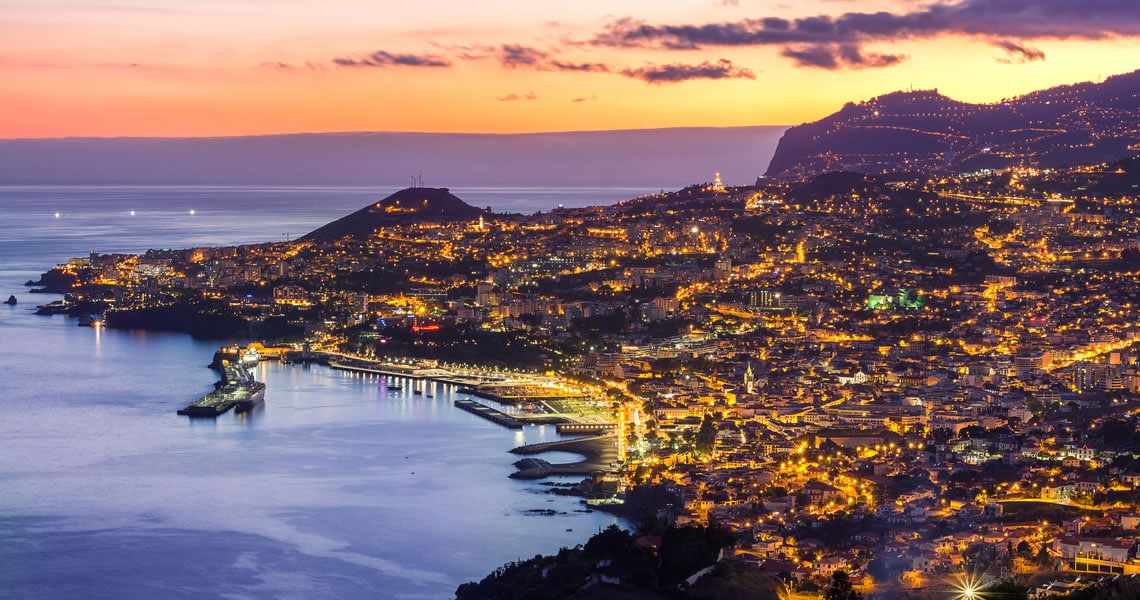
Situated in a bay bathed by the Atlantic Ocean, on the south coast of the island of Madeira, Funchal is the capital of Madeira.
This town that dates back some 600 years, since 21st August 1508, owes its name to a sweet-smelling wild herb, the “Foeniculum Vulgare” traditionally known as fennel [funcho], which existed in abundance at the time of its settlement.
Funchal is the largest tourist, cultural and commercial center of the archipelago of Madeira. This city offers a wide range of leisure activities, from visits to museums, monuments and other landmarks, to walks in its beautiful gardens, walks along the Marina of Funchal full of boats, shopping and going out at night to bars and nightclubs.
In the form of an amphitheater, the Municipality of Funchal stretches along a hillside that goes from sea level to the Pico de Areeiro, at 1 818m altitude.
This town that dates back some 600 years, since 21st August 1508, owes its name to a sweet-smelling wild herb, the “Foeniculum Vulgare” traditionally known as fennel [funcho], which existed in abundance at the time of its settlement.
Funchal is the largest tourist, cultural and commercial center of the archipelago of Madeira. This city offers a wide range of leisure activities, from visits to museums, monuments and other landmarks, to walks in its beautiful gardens, walks along the Marina of Funchal full of boats, shopping and going out at night to bars and nightclubs.
In the form of an amphitheater, the Municipality of Funchal stretches along a hillside that goes from sea level to the Pico de Areeiro, at 1 818m altitude.
Câmara de Lobos
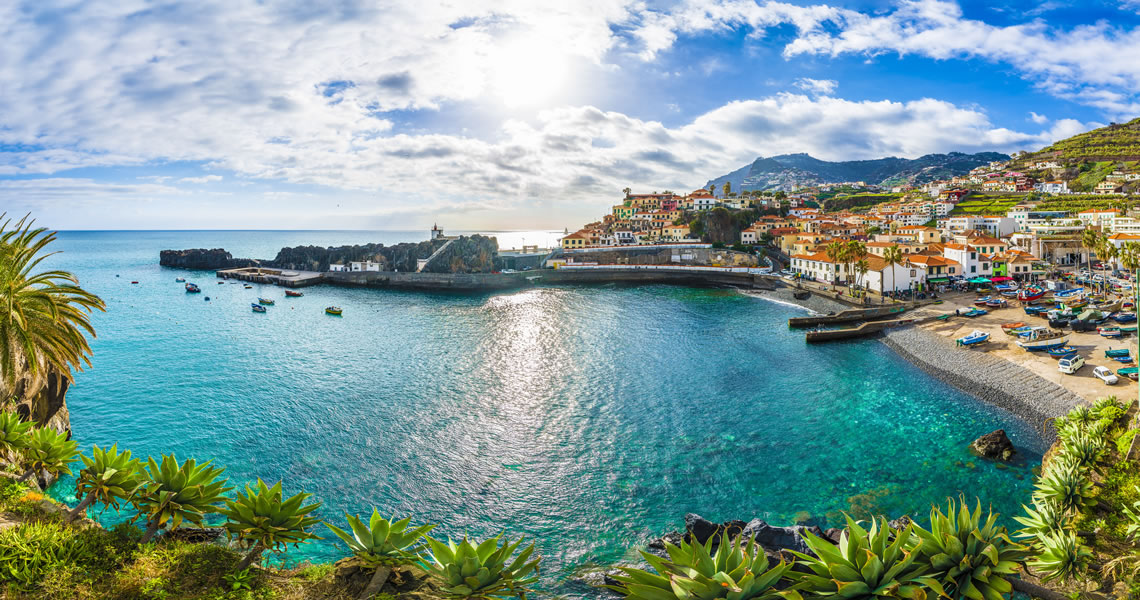
Câmara de Lobos is a city and the county seat of the parish, on the south coast of the Madeira Island. The municipality of Câmara de Lobos has about 35,000 inhabitants spread over an area of 51.82 km2.
The name of this parish comes from the fact that at the time of the discovery of the island loads of sea lions were sighted at that cove that still retains the same configuration. Currently these animals appear only occasionally on the south coast of the island, with a colony preserved in the Desert Islands.
The main economic activities of the parish are fishing, agriculture with emphasis on Wine production, trade, services and industry.
The name of this parish comes from the fact that at the time of the discovery of the island loads of sea lions were sighted at that cove that still retains the same configuration. Currently these animals appear only occasionally on the south coast of the island, with a colony preserved in the Desert Islands.
The main economic activities of the parish are fishing, agriculture with emphasis on Wine production, trade, services and industry.
Ribeira Brava
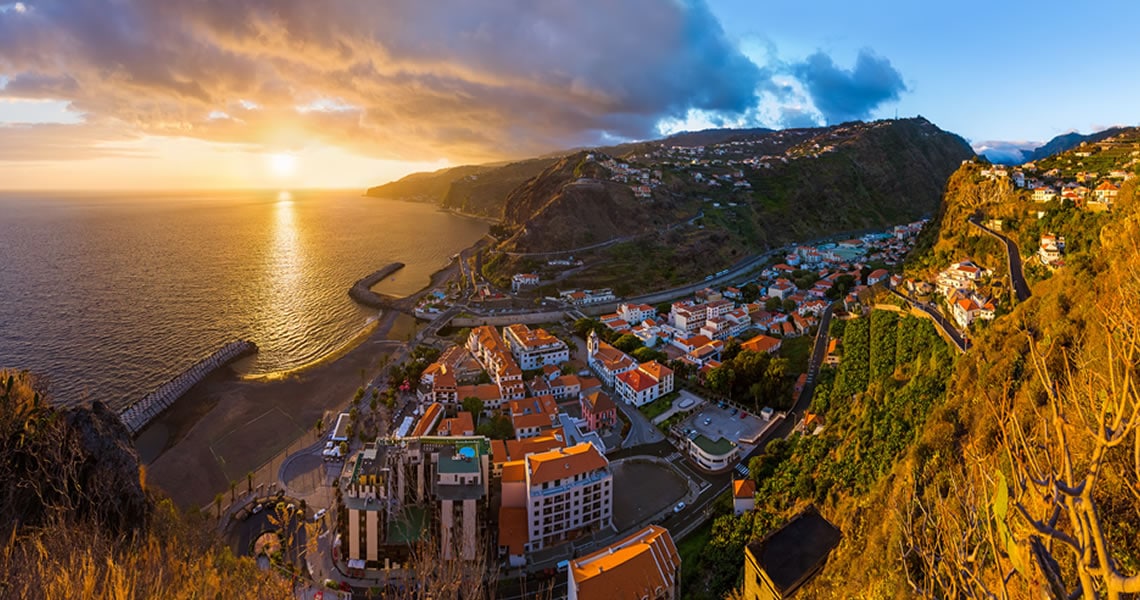
Located on the south coast of the island, the municipality of Ribeira Brava has an area of approximately 65.10 km2 with about 12,500 inhabitants.
Its main economic activity is agriculture; from the cultivation of land comes sweet potatoes, beans, vegetables, some cereal, fruit and wine.
Its main economic activity is agriculture; from the cultivation of land comes sweet potatoes, beans, vegetables, some cereal, fruit and wine.
Ponta do Sol
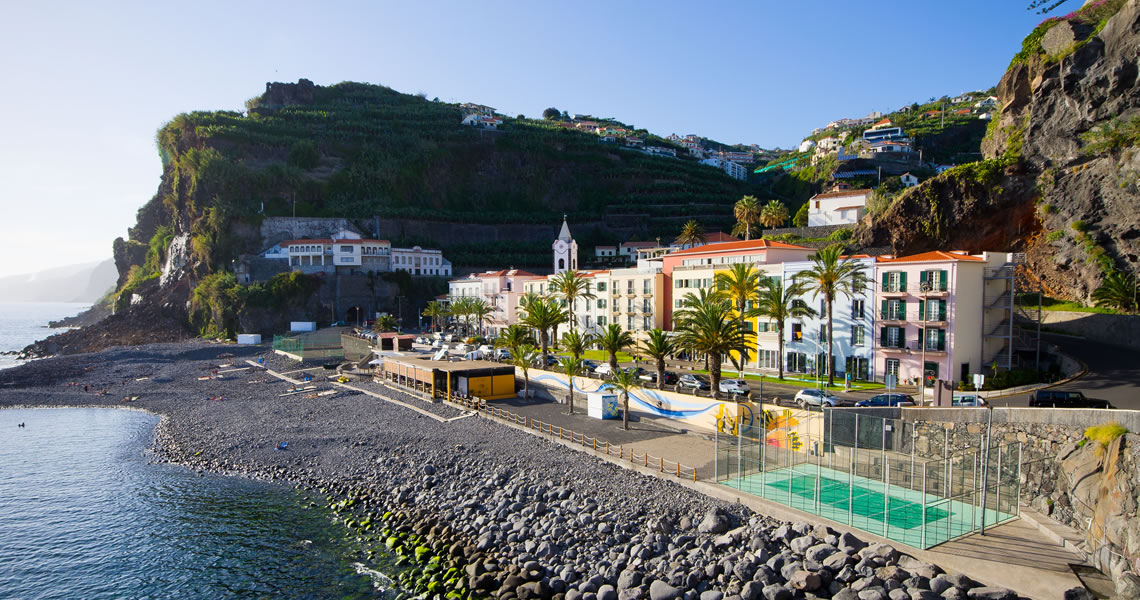
Situated on the south coast of the island, Ponta do Sol is currently the county seat, and has about 8,200 inhabitants in its area of 43.3 km2.
This is considered the hottest municipality of the island; it is also here where the sun shines for more hours.
Economic activity is based on the primary sector, which includes agriculture, predominantly the production of sugar cane, banana, horticulture and floriculture. Another highlight is the traditional trade and hotels. In the municipality there is a company exporting plants.
This municipality has the Paul da Serra, which is distinguished for being the only plateau on the island of Madeira, and this at an altitude of 1,500 m. This site has unique natural features, due to its size and location, as nuclei of indigenous vegetation, wildlife species and migratory birds. In Paul da Serra there are wind turbines that produce electricity in a non-polluting manner.
In this town you can also visit the Ponta do Sol Pier, Lagoa do Lugar de Baixo and the Subtropical Floriculture Centre.
This is considered the hottest municipality of the island; it is also here where the sun shines for more hours.
Economic activity is based on the primary sector, which includes agriculture, predominantly the production of sugar cane, banana, horticulture and floriculture. Another highlight is the traditional trade and hotels. In the municipality there is a company exporting plants.
This municipality has the Paul da Serra, which is distinguished for being the only plateau on the island of Madeira, and this at an altitude of 1,500 m. This site has unique natural features, due to its size and location, as nuclei of indigenous vegetation, wildlife species and migratory birds. In Paul da Serra there are wind turbines that produce electricity in a non-polluting manner.
In this town you can also visit the Ponta do Sol Pier, Lagoa do Lugar de Baixo and the Subtropical Floriculture Centre.
Porto Moniz
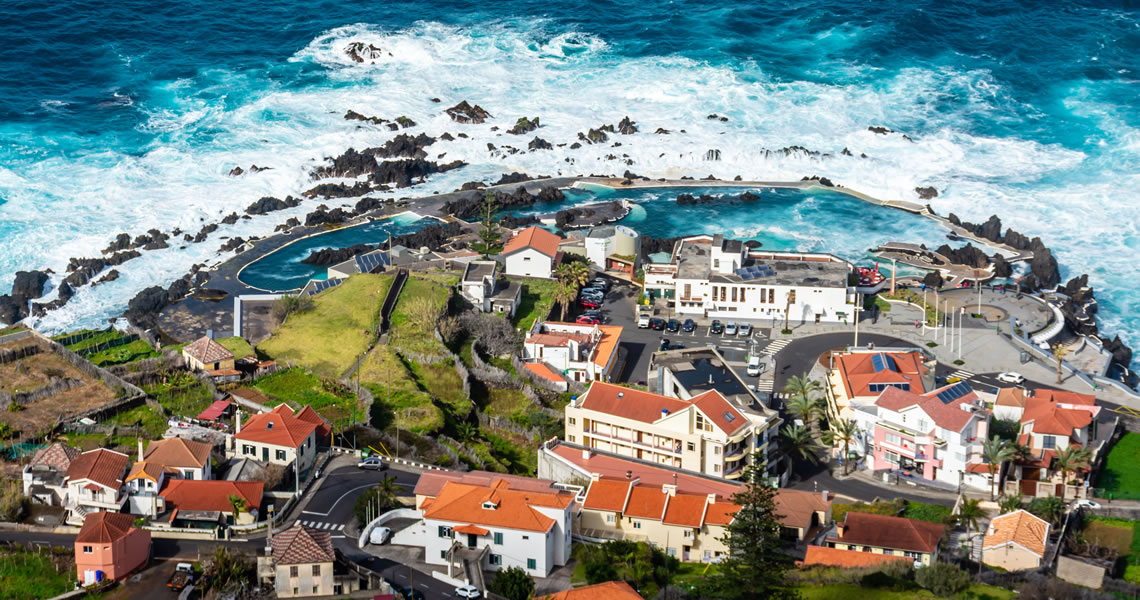
Located in the north of the island of Madeira, the municipality of Porto Moniz has about 3,000 inhabitants distributed over a geographical area of 80.40 km2.
Porto Moniz was finally connected to the rest of the island after World War 2, when the emblematic road connecting Porto Moniz to the municipality of São Vicente was built. This road was literally dug into the hillside, and is occasionally crossed by waterfalls that flow into the sea. This is considered one of the most beautiful roads in wood. For safety reasons, due to falling rocks, today there are tunnels that shorten the distance, but still allow the passage through the most emblematic places along the road.
Porto Moniz was finally connected to the rest of the island after World War 2, when the emblematic road connecting Porto Moniz to the municipality of São Vicente was built. This road was literally dug into the hillside, and is occasionally crossed by waterfalls that flow into the sea. This is considered one of the most beautiful roads in wood. For safety reasons, due to falling rocks, today there are tunnels that shorten the distance, but still allow the passage through the most emblematic places along the road.
São Vicente
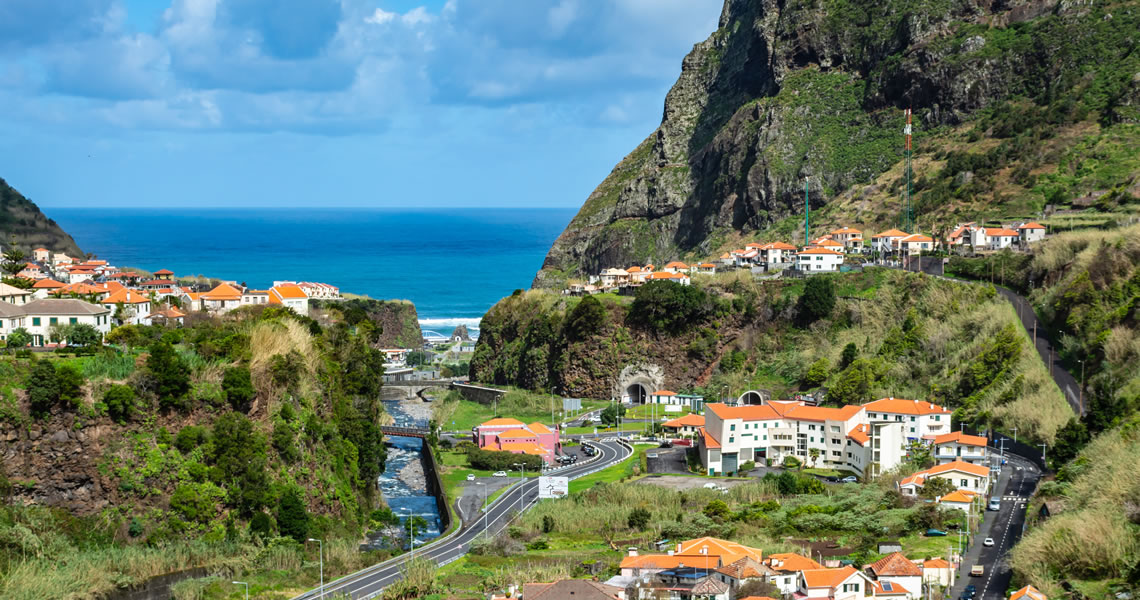
The municipality of São Vicente is located on the north coast of the island of Madeira, and has about 6000 inhabitants spread over an area of 78.70 km2.
São Vicente is an area characterized by green nature and abundant forest, modelled by volcanic forces and erosion in its beautiful slopes. One of the most representative symbols of the picturesque town of São Vicente is the small chapel built inside a basalt rock at the mouth of the stream that runs through the town.
Their predominant economic activity is based on the primary and tertiary sectors, particularly in agriculture and services, with emphasis on tourism.
In the heart of São Vicente one finds the Indigenous Garden, with an area of 2,200 m2, where dozens of species of local flora are represented.
The Museum Centre Rota do Cal (Lime Route) situated in this parish, is composed of a pedestrian trip that takes about 30 minutes from the quarries of limestone extraction to the museum.
From the Encumeada Belvedere, in Ribeira Brava, we have magnificent views of the mountain range that crosses Madeira and various areas of São Vicente, namely the Laurel Forest.
In the parish of São Vicente there is an extensive area of Laurel Forest. The importance of laurel is due to both its representation in terms of diversity of species of flora and fauna and the respective state of conservation. The Laurel Forest was classified as a Natural Heritage Site of UNESCO in 1999.
São Vicente is an area characterized by green nature and abundant forest, modelled by volcanic forces and erosion in its beautiful slopes. One of the most representative symbols of the picturesque town of São Vicente is the small chapel built inside a basalt rock at the mouth of the stream that runs through the town.
Their predominant economic activity is based on the primary and tertiary sectors, particularly in agriculture and services, with emphasis on tourism.
In the heart of São Vicente one finds the Indigenous Garden, with an area of 2,200 m2, where dozens of species of local flora are represented.
The Museum Centre Rota do Cal (Lime Route) situated in this parish, is composed of a pedestrian trip that takes about 30 minutes from the quarries of limestone extraction to the museum.
From the Encumeada Belvedere, in Ribeira Brava, we have magnificent views of the mountain range that crosses Madeira and various areas of São Vicente, namely the Laurel Forest.
In the parish of São Vicente there is an extensive area of Laurel Forest. The importance of laurel is due to both its representation in terms of diversity of species of flora and fauna and the respective state of conservation. The Laurel Forest was classified as a Natural Heritage Site of UNESCO in 1999.
Santana
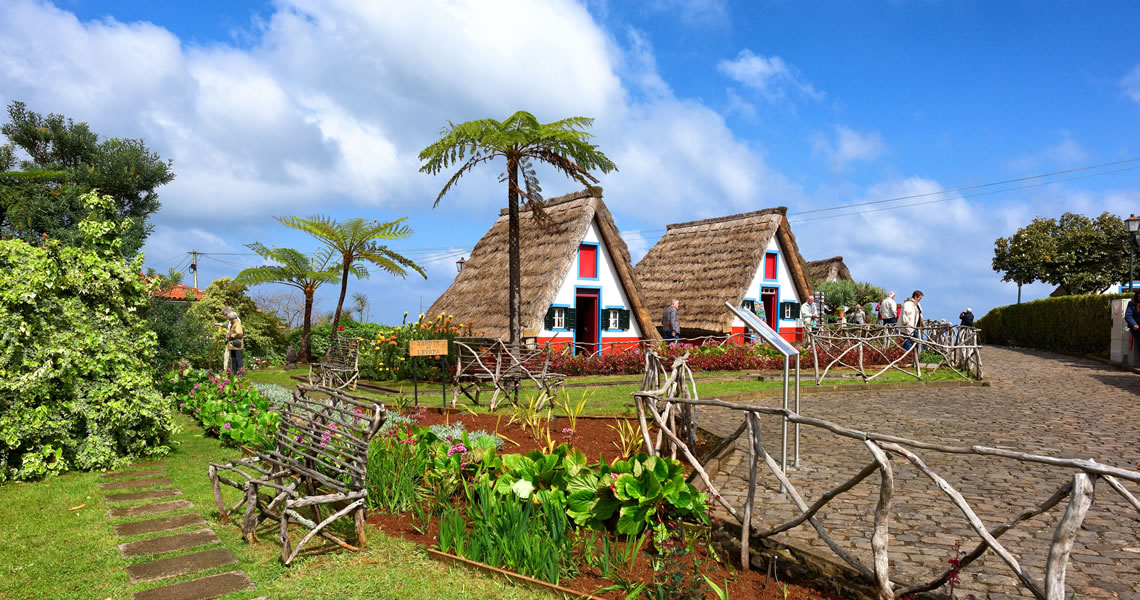
The municipality of Santana, located on the north coast of Madeira island, has an area of 96.2 km2 inhabited by about 8,800 people.
The name of this town is due to a primitive chapel dedicated to Santa 'Ana, which gave rise to the present church.
Because the municipality was inaccessible by sea and land, its inhabitants have preserved features that have not suffered outside influences. One example that comes from this isolation is the typical architectural style of their houses with thatched roofs known as “casinhas de Santana” (little houses of Santana).
The tourism sector is currently the main economic resource of this county.
Here, you can visit the Madeira Theme Park and the Natural Reserve of Rocha do Navio.
In June 2011, the municipality of Santana received the distinction of “Biosphere Reserve” by UNESCO recognizing the richness of an ecosystem where it seeks to reconcile biodiversity conservation and sustainable use. This reserve includes a land component, corresponding to the entire surface of the municipality above sea level and still a marine component, which presents a wide variety of natural and unique human, landscape, environmental and cultural values of local, regional, national and international interest.
In Santana, one finds Biosphere Routes that span over more than 120 km and allow visitors to enjoy the vast natural heritage, contemplate the landscaped surroundings, enjoy nature, meet the cultural richness of the places and engage with the local population. Here you find the pedestrian trails of Vereda do Pico Ruivo, Levada do Rei and Levada do Caldeirão Verde.
The name of this town is due to a primitive chapel dedicated to Santa 'Ana, which gave rise to the present church.
Because the municipality was inaccessible by sea and land, its inhabitants have preserved features that have not suffered outside influences. One example that comes from this isolation is the typical architectural style of their houses with thatched roofs known as “casinhas de Santana” (little houses of Santana).
The tourism sector is currently the main economic resource of this county.
Here, you can visit the Madeira Theme Park and the Natural Reserve of Rocha do Navio.
In June 2011, the municipality of Santana received the distinction of “Biosphere Reserve” by UNESCO recognizing the richness of an ecosystem where it seeks to reconcile biodiversity conservation and sustainable use. This reserve includes a land component, corresponding to the entire surface of the municipality above sea level and still a marine component, which presents a wide variety of natural and unique human, landscape, environmental and cultural values of local, regional, national and international interest.
In Santana, one finds Biosphere Routes that span over more than 120 km and allow visitors to enjoy the vast natural heritage, contemplate the landscaped surroundings, enjoy nature, meet the cultural richness of the places and engage with the local population. Here you find the pedestrian trails of Vereda do Pico Ruivo, Levada do Rei and Levada do Caldeirão Verde.
Machico
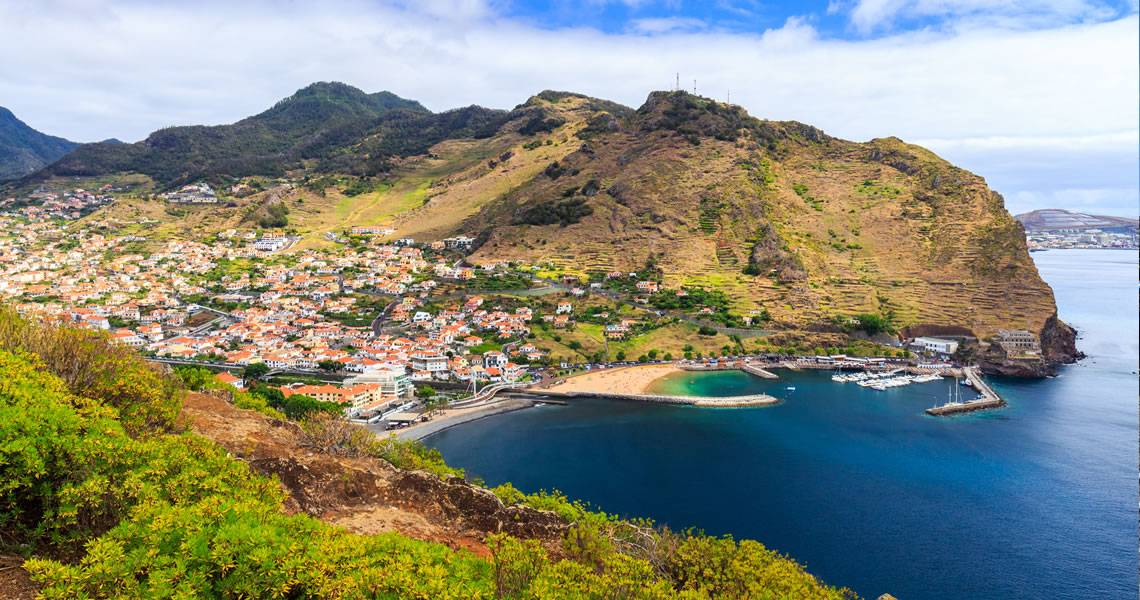
Located on the east coast of Madeira Island, approximately 22 km from Funchal, this municipality has a great historical significance.
It was here that Gonçalves Zarco and Tristão Vaz Teixeira disembarked, in 1419, when they discovered Madeira.
Machico became town on 2nd August 1996 and has about 20,000 inhabitants distributed among its 68 km2.
Legend has it that already a century before this discovery, Robert Machim and Anna d'Arfet had found refuge here. The distortion of the name Machim resulted in the name of this city.
The bay of Machico invites for a walk amidst the amazing view over sea and land. To the east of the Machico valley is the Pico de Facho Belvedere, from where you can admire the panoramic views from the peaks of the central area of the island up to the Ponta de São Lourenço.
The Banda Além beach, in the bay of Machico, is about 125 meters long and 70 meters wide. This beach is distinguished for its yellow sand, imported from Morocco.
It was here that Gonçalves Zarco and Tristão Vaz Teixeira disembarked, in 1419, when they discovered Madeira.
Machico became town on 2nd August 1996 and has about 20,000 inhabitants distributed among its 68 km2.
Legend has it that already a century before this discovery, Robert Machim and Anna d'Arfet had found refuge here. The distortion of the name Machim resulted in the name of this city.
The bay of Machico invites for a walk amidst the amazing view over sea and land. To the east of the Machico valley is the Pico de Facho Belvedere, from where you can admire the panoramic views from the peaks of the central area of the island up to the Ponta de São Lourenço.
The Banda Além beach, in the bay of Machico, is about 125 meters long and 70 meters wide. This beach is distinguished for its yellow sand, imported from Morocco.
Santa Cruz
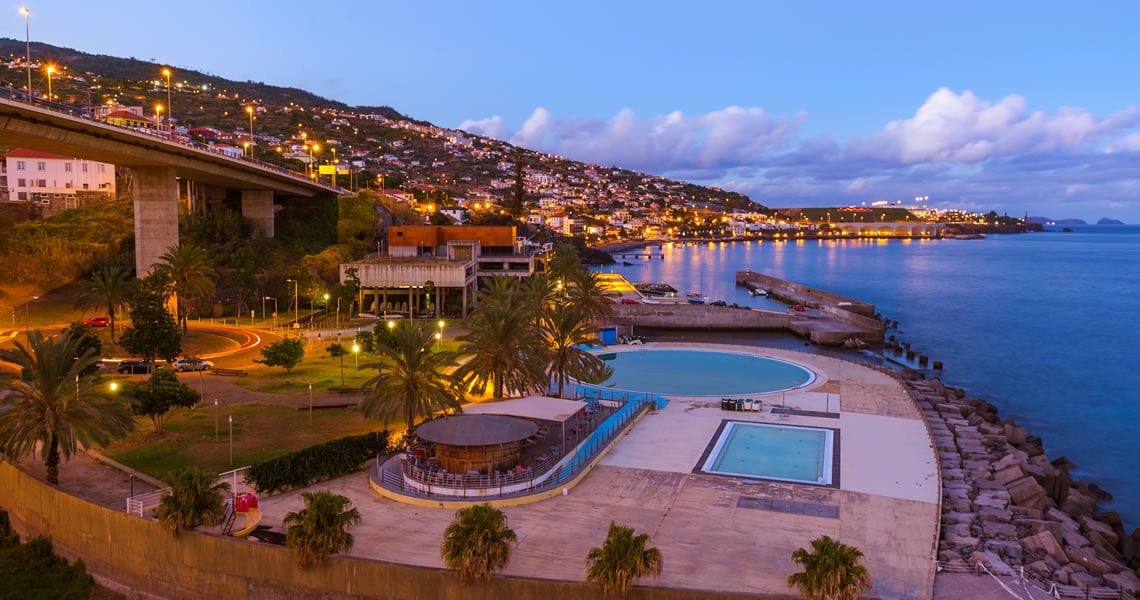
It is in this county on the east coast, situated about 18 km from the capital, that the Madeira International Airport is located.
Throughout several cultural exhibitions that display works by regional artists and others take place at Casa da Cultura de Santa Cruz (Culture House).
Throughout several cultural exhibitions that display works by regional artists and others take place at Casa da Cultura de Santa Cruz (Culture House).
Porto Santo
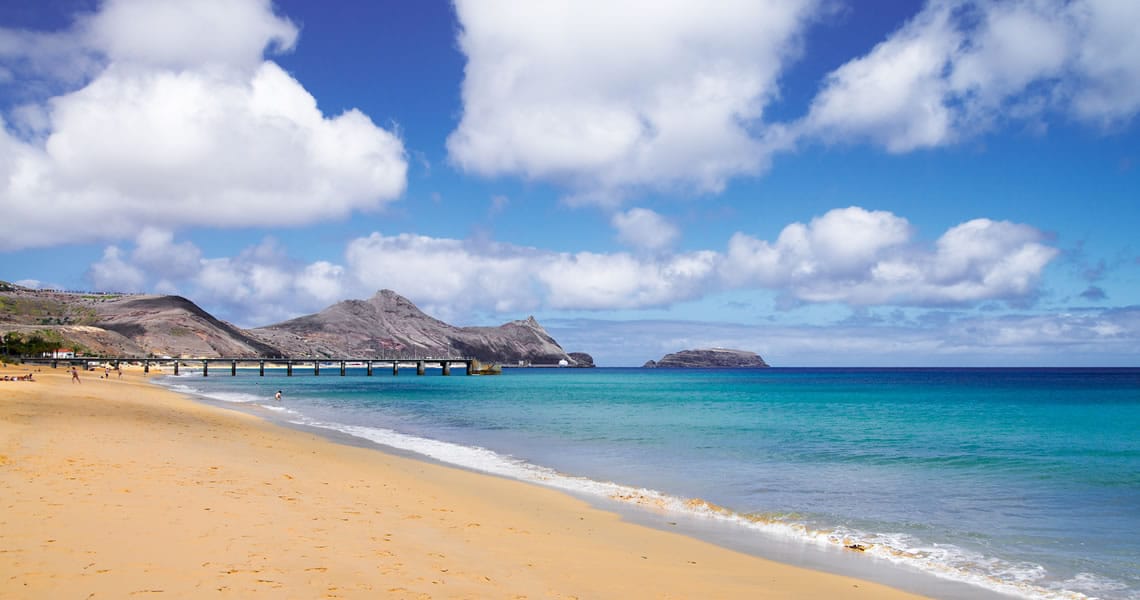
Porto Santo is the second largest island of the Autonomous Region of Madeira, with 42.48 km² and 5 483 people. The capital is the city of Vila Baleira. Porto Santo is also a Portuguese municipality. Located in the Atlantic Ocean, in the extreme south-west of Europe and just 500 km from the African coast and 1,000 km from Europe, you can fly in from Lisbon in a 1 ½ hour flight.
The island is known for its large fine yellow sandy beach, stretching close to 9 km, running along the island’s entire southern coastline, between the harbour and Calheta. Above all, it offers peace and quiet and a catching charm, which doesn’t leave any visitor indifferent. A particular highlight is the island’s sea water temperature; it is really warm all year round. Porto Santo’s climate is dry and stable, with little variation in warmness from season to season, therefore is usual to go to the beach throughout the year.
In terms of economic activities, due to the natural features of Porto Santo, means that agriculture is poor and therefore, most of its economy is based on trading and services. Over recent years, there has been a boost in tourism, largely as a result of the new ferry connecting Madeira to Porto Santo, by the boat “Lobo Marinho”. This progress has led to the construction of new hotels and restaurants, of increasingly good quality.
Porto Santo’s major cultural icon is Christopher’s Columbus House Museum, indicating the presence of America’s discoverer on the island. The museum aims to recreate the primitive environment in which the explorer lived. Columbus’ house is, in fact, two buildings, the older of which dates back to the time when the navigator was on the island. Aside from portraits of Columbus spanning the 16th to the 20th centuries, the exhibition also contains maps showing the different routes travelled by him.
Porto Santo Golf offers unique sporting challenges and superb views. Surrounded by serene landscapes and enveloped by sea breeze, the Porto Santo golf course boasts perfect year-round golfing conditions.
Vila Baleira, the only urban centre in Porto Santo, was given the city status on August 6th, 1996. Porto Santo also gives name to the municipality and also to the only parish on the island.
The island is known for its large fine yellow sandy beach, stretching close to 9 km, running along the island’s entire southern coastline, between the harbour and Calheta. Above all, it offers peace and quiet and a catching charm, which doesn’t leave any visitor indifferent. A particular highlight is the island’s sea water temperature; it is really warm all year round. Porto Santo’s climate is dry and stable, with little variation in warmness from season to season, therefore is usual to go to the beach throughout the year.
In terms of economic activities, due to the natural features of Porto Santo, means that agriculture is poor and therefore, most of its economy is based on trading and services. Over recent years, there has been a boost in tourism, largely as a result of the new ferry connecting Madeira to Porto Santo, by the boat “Lobo Marinho”. This progress has led to the construction of new hotels and restaurants, of increasingly good quality.
Porto Santo’s major cultural icon is Christopher’s Columbus House Museum, indicating the presence of America’s discoverer on the island. The museum aims to recreate the primitive environment in which the explorer lived. Columbus’ house is, in fact, two buildings, the older of which dates back to the time when the navigator was on the island. Aside from portraits of Columbus spanning the 16th to the 20th centuries, the exhibition also contains maps showing the different routes travelled by him.
Porto Santo Golf offers unique sporting challenges and superb views. Surrounded by serene landscapes and enveloped by sea breeze, the Porto Santo golf course boasts perfect year-round golfing conditions.
Vila Baleira, the only urban centre in Porto Santo, was given the city status on August 6th, 1996. Porto Santo also gives name to the municipality and also to the only parish on the island.



